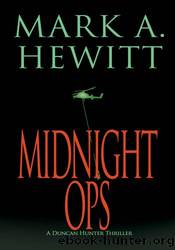Midnight Ops by Mark A. Hewitt

Author:Mark A. Hewitt [Hewitt, Mark A.]
Language: eng
Format: epub
Published: 2024-03-07T00:00:00+00:00
Chapter 41
July 18, 2020
Nine men exited three vehicles. They wore dark ballcaps, polo shirts, and light jackets as they walked across the tarmac at the Tolbert Field Airport. They entered a pristine Douglas DC-3 in Pan American Airways livery and found a seat. The interior smelled of aviation gasoline.
One man said, âThis thing scares me. I think this deserves hazardous duty pay.â
Another one said, âNice try. How do you think this thing got so old?â
Retired four-star general and Air Force fighter pilot, CIA Director Walter Todd, call sign Magoo, took the copilot position and assisted Duncan Hunter, call sign Maverick, in the pre-start duties of the old twin radial. While the powerplants were over eighty years old, the cockpit had completely modern flat panel displays and resembled the flight deck of the newest corporate jets. In-flight internet, a satphone, and a STU-III (Secure Telephone Unit) were available in the cabin. The flight plan listed Maine as the destination. Magoo selected the coordinates for Portland in the GPS. Maverick started the engines and made the required radio calls for permission to taxi.
Magoo asked, âWhat do these engines run on?â
Maverick responded, âIf I hadnât taken the Mazibuike administration to court, theyâd be running on 87 octane, car gas. Now the Three Rivers Refinery near Hondo again produces 115/145 octane for warbird engines, especially for these radials.â
âI donât understand.â
Over the Bose® headset, Maverick explained, âYou know about Jimmy Doolittle; he was still in the Army reserves when he was hired to run Shell Oil Companyâs aviation department. Doolittle wanted aviation fuels with octane ratings of over 100 so engine designers could make higher performance engines with higher compression ratios. The aircraft that carried these advanced engines would have stunning performance, especially at higher altitudes where the air is very cold, and where enemy aircraft had a distinct disadvantage: they could not reach them. All a function of octane.â
Magoo nodded, âI didnât know that. I flew jets.â
Maverick said, âLiberals hate petroleum and they really hate gasoline, but if you want to see them melt down, mention aviation gasoline. They hate it because it won the big one. WWII.â
âSeriously?â
âIt is a secret that is rarely told. The first large-scale plant dedicated to producing higher octane fuel came online in 1940, and the British were able to change their aircraft engines to use the new fuel from America for the Battle of Britain. The boosted, meaning turbocharged, engine performance of the aircraft shocked the Germans. The speed of the Spitfire increased from 340 miles per hour in 1939 to 425 miles per hour in 1944. The normal avgas used by Germany throughout WWII was what they call B-4, which had an octane rating of 91/100. The Nazis were trying to catch up with experimental fuels having octane ratings as high as 150, but the allies destroyed the Naziâs refining capability, which prevented any use of the higher-octane avgas for Axis aircraft. Now, Mazibuike was all about global warming and hated gasoline of all shades.â
âShades?â
âYeah, aviation fuels come in colors and 115/145 is dyed purple.
Download
This site does not store any files on its server. We only index and link to content provided by other sites. Please contact the content providers to delete copyright contents if any and email us, we'll remove relevant links or contents immediately.
Colleen Hoover Ebook Boxed Set Hopeless Series by Colleen Hoover(1302)
In Too Deep (Jack Reacher) by Lee Child & Andrew Child(1177)
SCORCHED EARTH by Ryan L.T. & Pearce Biba(1139)
The Bad Parents by S.L. Harker(1085)
The Secret Hours by Mick Herron(1014)
Hold Me Closer (The Charing Cross Boys Book 4) by M. Katherine Clark(975)
The Lie Between Us by Amanda McKinney(893)
Dead Fall by Brad Thor(847)
The Perfect Assassin by James Patterson(827)
Kill For Me Kill For You: The twisting new thriller from the Sunday Times bestseller by Steve Cavanagh(822)
The Ninth Month by James Patterson(792)
Tom Clancy Flash Point by Don Bentley(769)
The Doomsday Spiral by Jon Land(759)
The Secret: A Jack Reacher Novel by Lee Child & Andrew Child(755)
Unforgiving Savage by Dave Edlund(727)
The Devil's Ransom by Brad Taylor(719)
Blind Spots by Thomas Mullen(676)
3rd Degree - v4 by James Patterson(659)
Scroll (Relic Hunters Taskforce Book 1) by Ruth Hartzler(657)
